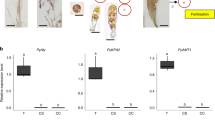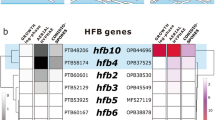Abstract
IN 1953, it was suggested1 that genesis of ordinary colourless and orange thalli of Blastocladiella emersonii was related to the distribution of a hypothetic cytoplasmic factor, gamma, the rate of reproduction of which relative to growth of the protoplast was affected differentially by environmental factors. Later2, a visible, Nadi-positive, cytoplasmic particle was detected, the distribution of which in the motile swarmers derived from ordinary colourless and orange plants corresponded with that predicted for the hypothetical factor, gamma; namely, a low number per spore for orange plants, and a higher number per spore for ordinary colourless plants. The number of these visible particles was, indeed, affected by environmental factors; furthermore, it appeared as if they might be transferred from one cell to another via temporary cytoplasmic bridges formed between orange and colourless motile cells3. In addition, studies with a mutant strain of B. emersonii which produced only orange plants revealed that: (a) the gamma content per mutant swarmer was the same as the gamma content of the wild-type orange swarmers from orange plants2; (b) such mutant, orange plants displayed a respiratory lesion in the tricarboxylic acid cycle; namely, they lacked the oxidative activity associated with α-ketoglutarate dehydrogenase normally found in the wild type4,5. In recent years, it has begun to appear6 as if cytoplasmic control of differentiation of orange and colourless cells in the close relative Allomyces may also be related to the distribution of similar, Nadi-positive particles, particularly in view of the recent demonstration9 of a parallel sort of differential distribution of Nadi-positive ‘mitochondria’ in the unicellular orange and colourless sex organs of this fungus.
This is a preview of subscription content, access via your institution
Access options
Subscribe to this journal
Receive 51 print issues and online access
$199.00 per year
only $3.90 per issue
Buy this article
- Purchase on Springer Link
- Instant access to full article PDF
Prices may be subject to local taxes which are calculated during checkout
Similar content being viewed by others
References
Cantino, E. C., and Hyatt, M. T., “Antonie v. Leeuwenhoek,”, 19, 25 (1953).
Cantino, E. C., and Horenstein, E. A., Mycologia, 48, 443 (1956).
Cantino, E. C., and Horenstein, E. A., Amer. Naturalist, 88, 143 (1954).
Cantino, E. C., and Hyatt, M. T., Amer. J. Bot., 40, 688 (1953).
Cantino, E. C., and Hyatt, M. T., J. Bact., 66, 712 (1953).
Cantino, E. C., and Turian, G. F., Ann. Rev. Microbiol., 13 (1959).
Turian, G., Rev. Cytol., Biol. Veg., 19 (1958).
Warburg, O., Science, 123, 309 (1956).
Hino, S., and Lindegren, C. C., Exp. Cell Res., 15, 628 (1959).
Author information
Authors and Affiliations
Rights and permissions
About this article
Cite this article
CANTINO, E., TURIAN, G. Gamma Particles, Nadi-Positive Mitochondria, and Development in the Water Fungi Blastocladiella and Allomyces . Nature 184, 1889–1890 (1959). https://doi.org/10.1038/1841889a0
Issue Date:
DOI: https://doi.org/10.1038/1841889a0
This article is cited by
-
A stable mitomycin-induced LC-type albino mutant of Blastocladiella emersonii
Mycopathologia et Mycologia Applicata (1970)
-
Metabolic changes during sexual differentiation in Allomyces
Archiv f�r Mikrobiologie (1967)
Comments
By submitting a comment you agree to abide by our Terms and Community Guidelines. If you find something abusive or that does not comply with our terms or guidelines please flag it as inappropriate.



